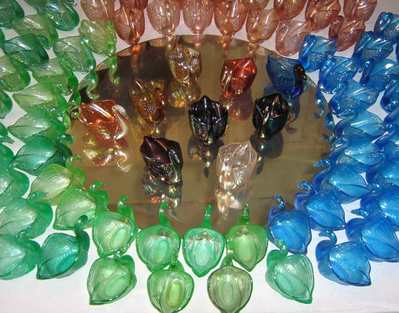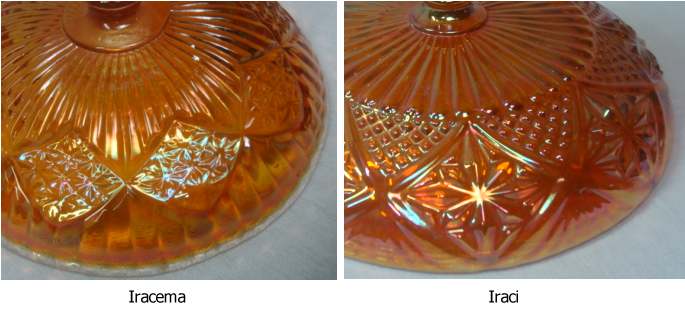NetworK ezine Issue 4. September 2015
by Glen and Stephen Thistlewood
Welcome to the latest issue of Carnival Glass NetworK. Also, welcome to the very many new readers who signed up recently! If you missed any previous issue of Carnival Glass NetworK, they are all on the Back Issues page of our website: NetworK Back Issues.
Swanning Around!
Woah! Stop right there! What’s this? You thought you were reading a Carnival Glass article and it turns into the Chicago Sunday Tribune?
|
The date on the Tribune’s mast was September 1928, eighty seven years ago.
September is the time that the kids go back to school, and the Tribune ran a special feature that weekend for girls who were returning to school. Other gifts in the article included desk scissors, a book light and a tea set “for the departing student”. The ad is shown on the right. The swans, however, are fascinating; the one on the right of the black and white newspaper picture is described as being “in iridescent glass, the kind that is often spoken of as opalescent”. The misuse of opalescent (for iridescent) was not unusual and indeed it still persists today. It referred to a Carnival Glass Swan (sometimes called Pastel Swan or Swan Salt) which was made in a variety of colours in Classic Carnival by both Fenton and Dugan-Diamond - an ice green example is pictured on the far right, for comparison. |
Lance and Pat Hilkene have amassed an amazing "flock" of Carnival Glass Swans, just some of which are pictured below, left. The total number is around 260, including ice green, teal, celeste and sapphire blue, purple, amethyst, vaseline, pink (in many shades), amber, white, marigold, and peach opal.
Dugan is considered to have been the first to make Classic (old) Carnival Glass Swans, and Classic production continued with Dugan-Diamond and Fenton.
Lance tells us that he believes these were the only makers of old swans in Carnival Glass. He explained: “The old Fenton swans are easy to distinguish by the definitive lines in the wings. The Dugan wings are more stylized and the wings have a more random look to them.” There’s no doubt that there are other minor mould variations.
|
Contemporary Swans When Carnival Glass was revived (from the 1960s/70s onwards), both Imperial and Fenton made swans in contemporary Carnival in a variety of colours. They were marked IG/LIG and Fenton respectively. On the right, is a contemporary Imperial Swan in red Carnival. It is easy to spot an Imperial swan as it has feathers instead of dots on its neck (as well as the trademark). The original inspiration Were these pretty swans inspired by another previous swan? We think so. Burtles and Tate in Manchester, England, registered a swan novelty as early as 1885. It is a much sought-after, opalescent glass item, known in rose pink, clear and vaseline. But it’s likely that the Burtles and Tate swan was inspired by an even earlier swan, registered in 1874 by Jane Webb in Stourbridge, England. |
Elsewhere on Carnival Glass Worldwide, we explore the original English inspiration for these wonderful swan salts, and reveal fascinating links between some famous English and American master glassmakers. Read it here: more Swanning Around!
Jacobean, made by Josef Inwald
Here is an extract from a 1928 Markhbeinn catalogue of Josef Inwald's glass, showing all five sizes of the Jacobean tumbler ("Gobelets") that they made in marigold Carnival Glass - intended for (smallest to largest size) liqueurs, port, madeira, wine and water.
Jacobean, made by Josef Inwald
Here is an extract from a 1928 Markhbeinn catalogue of Josef Inwald's glass, showing all five sizes of the Jacobean tumbler ("Gobelets") that they made in marigold Carnival Glass - intended for (smallest to largest size) liqueurs, port, madeira, wine and water.
|
Jacobean originated in Czechoslovakia, where it was introduced by Josef Inwald in 1921. It was widely marketed in the UK, and the advert on the right from 1926, is for Gibson’s China Rooms in Hull, England. It was clearly a break from their usual goods on offer: no china here – this was glass. In fact their ad went on to describe a “Special two window show of this beautiful glassware” – JACOBEAN registered Trade Mark GLASSWARE. It's hard to spot it in the ad, but underneath the decanter are the words REGD DESIGN: in 1923 the pattern was indeed registered in the UK by the importer and wholesaler, Clayton Mayers, and some items actually have moulded numbers on them. The items shown in the ad were the pitcher, tumbler, stemmed liqueur glass and decanter, all of which were made by Inwald in Czechoslovakia at that time. Of course, we can’t be sure that the items in Gibson’s China Rooms included Carnival examples, but it’s highly likely that they did. We know that the pitcher and five sizes of tumbler were made in marigold Carnival, and also the decanter (pictured above right, courtesy of Michael O'Brien). Jacobean (also known as "Milord" and simply "Lord") was made in an amazing number of shapes - around 250 - of which about 20 are known in Carnival. But ... what about the stemmed liqueur glass shown in the ad? Does anyone have one? |
|
Inwald’s Jacobean pattern was very successful: it had many followers and subsequent look-alikes, including the slightly later Ranger pattern made by Imperial and by other makers. The line drawing of the Imperial Ranger tumbler is from their Nov. 1922 patent application. Stop Press: a shape not seen before in Carnival has recently been spotted in rich marigold - a rosebowl. We found the shape listed in a Clayton Mayers’ catalogue of Jacobean items, shown far right. Note the pinched in and flared cuspidor style top – wouldn’t it be lovely filled with roses? |
Carnival in Brazil
At the start of this Issue, we teased you with a picture of a very unusual piece of Carnival Glass, asking who made it and where.
The pattern is called Eye of the Queen, and it was made in Brazil.
For some time, we have said that Carnival Glass discoveries coming from South America will continue to excite and surprise us ... and that is certainly the case with Esberard. Thanks to local collector, researcher and glass enthusiast Claudio Deveikis, many of the South American discoveries are being made known to the Carnival Glass world, and we are proud to feature them on our website.
|
This beautiful stemmed comport (left), named Iracema by Claudio, is one of his latest "finds". What is especially exciting is that the name of the maker – Esberard – is moulded on the glass.
The pattern on the Iracema comport has stylistic links with Iraci, another Esberard piece discovered and named by Claudio, as shown above. Congratulations to Claudio for discovering these amazing pieces from Brazil. Discover more about Esberard. Explore more wonderful Carnival Glass from South America. |
Headhunted
We spotted this ad (right) in an 1858 British newspaper.
|
At first sight it seemed fairly ordinary: Sowerby’s were looking for a foreman for their pressed glass mould shop. The job description was interesting: “No one need apply unless he perfectly understands his business and can design well”.
OK, so they wanted someone who could bring specific design skills as well as craftsmanship to the role. But then we spotted something very interesting … the location of the newspaper in which the ad was published. Instead of it being in the north east of England where Sowerby was located, it was hundreds of miles away, in the area near Stourbridge which was famed for its glass production. Sowerby was headhunting outside their home area, possibly hoping to recruit from a firm such as Joseph Webb’s (the famed pressed glass firm in Stourbridge). |
|
The old newspaper "small ads" provided a fascinating insight into society at the time. On the right is an ad from the Sydney Morning Herald of 1928, for girls to work in Crown Crystal's packing department. At least they had to be 15 years old to work there. Of course, in the early 1900s it was not unusual for young children to carry out manual work in industrial premises - premises that did not benefit from today's Health and Safety protection. Here is a picture of the glass washing room at the Rindskopf glass works (Czechoslovakia) in the late 1920s/early 30s, where young girls were employed. Note the youngster on the right who appears to have climbed up the machinery to load something into it! Feedback We hope you have enjoyed this issue of our NetworK ezine. We aim to bring the next one out very soon. If you missed earlier issues, they are on our NetworK back issues page. Meanwhile, we would love to hear from you, and maybe you would like to "chat" with us on our Carnival Glass facebook pages. |

















